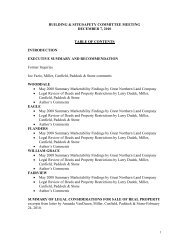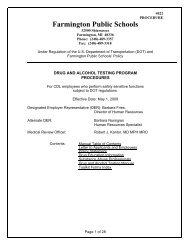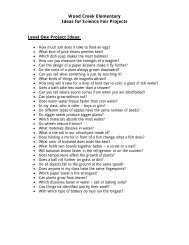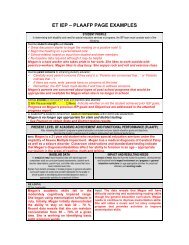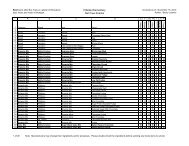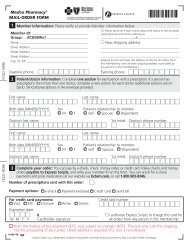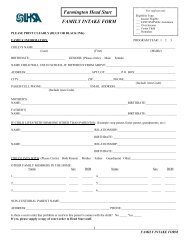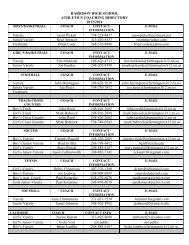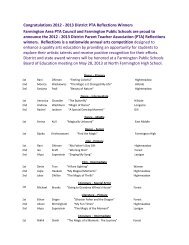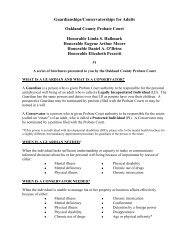Moles Packet 2013.pdf
Moles Packet 2013.pdf
Moles Packet 2013.pdf
- No tags were found...
Create successful ePaper yourself
Turn your PDF publications into a flip-book with our unique Google optimized e-Paper software.
CHEMISTRY B- MOLES PACKET NAME: __________________________________ HR: __________ PAGE 1Chemistry B<strong>Moles</strong> <strong>Packet</strong>
CHEMISTRY B- MOLES PACKET NAME: __________________________________ HR: __________ PAGE 2CHEMISTRY WORKSHEET # 1 MOLAR MASSWe are about to start on a unit of chemical calculations on how we calculate the relationships between theamounts of reactants and the amounts of products. For example, if we know the amount of reactants we have,we can use an organized, step-by-step approach to calculate how many products the chemical reaction willproduce.These problems involve numbers but no difficult mathematics. All you will ever have to do is add, multiply ordivide. You will be expected to have a functioning calculator with you for every chemistry class. As wesolve these problems we will apply the factor-label method you mastered early in the class, and we will frequentlyuse scientific notation.The only new concept we will introduce in this unit is the idea of a mole. A mole is a quantity of matter thatwe use for conversion purposes. We can convert from grams to moles, liters to moles (for gases), and atoms ormolecules to moles. If you can convert any of these things to moles (and therefore moles to any of these things)we can convert grams to liters or molecules, liters to grams of molecules, and molecules to liters or grams.# GRAMSMolar mass (gramsper mole)# MOLES6.02 X 10 23 atoms ormolecules per mole# MOLECULES22.4 liters of gas permole# LITERS (at STP)Molar mass tells us the mass (“weight”) of 1 mol of an atom or compound. In each case we simply calculate thesum of the “weights” of the atoms in the formula to determine the weight of a mole. These weights can befound on the periodic table.EXAMPLE: Calculate the molar mass of a mole of iodine, I 2 . Round to 2 decimal places.2 I = 2 X (126.90) = 253.80 g I 2 /molEXAMPLE: Calculate the molar mass of a mole of aluminum sulfate, Al 2 (SO 4 ) 3 . Round to 2 decimal places.2 Al = 2 X (26.98) = 53. 963 S = 3 X (32.07) = 64.14+ 12 O = 12 X (16.00) = 192.00__________________________________________Al 2 (SO 4 ) 3= 310.10 g Al 2 (SO 4 ) 3 /mol
CHEMISTRY B- MOLES PACKET NAME: __________________________________ HR: __________ PAGE 3CALCULATE THE MOLAR MASS FOR THE FOLLOWING COMPOUNDS OR DIATOMIC ELEMENTS.SET UP EACH PROBLEM AS SHOWN IN THE EXAMPLE ABOVE. INCLUDE UNITS (G/MOL)1. water H 2 O9. potassium chlorate KClO 38. ammonia NH 3 16. oxygen O 22. calcium chloride CaCl 210. lead(II) nitrate Pb(NO 3 ) 23. copper(II) sulfate CuSO 411. sodium oxalate Na 2 C 2 O 44. silver nitrate AgNO 312. zinc chloride ZnCl 25. sulfuric acid H 2 SO 413. magnesium oxide MgO6. calcium phosphate Ca 3 (PO 4 ) 214. antimony(III) chloride SbCl 37. sodium carbonate Na 2 CO 315. nitrogen N 2
CHEMISTRY B- MOLES PACKET NAME: __________________________________ HR: __________ PAGE 4CHEMISTRY WORKSHEET # 2: THE MOLE AS A UNIT OF MASSNow that you know how to find the mass of one mole of a substance (molar mass) you can easily find the mass ofseveral moles or the mass of a fraction of a mole using the factor-label technique.1 mol = a molar mass of an atom/molecule (g/mol)EXAMPLE: What is the mass of 5.00 moles of water H 2 0?STEP1: 2 H = 2 x( 1.01) = 2.02 STEP 2: ? grams H 2 0 = 5.00 moles H 2 0 x 18.02 g H 2 0 = 90.10 g H 2 OO = 1 x(16.00) = 16.00 1 mole H 2 0H 2 0 =18.02 gNOW YOU TRY ONE: What is the mass of 0.50 moles of calcium carbonate CaCO 3 ?STEP 1: Ca = STEP 2: ? g CaCO 3 =C =3O =CaCO 3 =USE A SEPARATE SHEET OF PAPER TO SOLVE THE FOLLOWING PROBLEMS. SHOW YOURWORK. ROUND MOLAR MASSES TO TWO PLACES AFTER THE DECIMAL. ADD UNITS.1. How many grams are there in 5.00 moles of lead Pb?2. How many grams are there in 2.00 moles of sulfuric acid H 2 SO 4 ?3. How many grams are there in 0.250 moles of sodium hydroxideNaOH?4. How many grams are there in 2.50 moles of potassium nitrate KNO 3 ?#1-5: You are giventhe number of molesand asked to find thegrams (mass)MOLS GRAMS5. How many grams are there in 10.0 moles of lithium carbonate Li 2 CO 3 ?Now that you know how to find the mass of one mole of a substance you can easily find the number of molesthere are in a given mass of the substance.EXAMPLE: How many moles of calcium chloride are there in 333 grams of calcium chloride (CaCl 2 )?STEP 1: Ca = 1 x(40.08)= 40.0 STEP 2: ?moles CaCl 2 = 333 grams CaCl 2 x 1 mole CaCl 2 = 3.00 mole CaCl 22 Cl = 2 x(35.45)= 70.90 110.98 g CaCl 2CaCl 2 = 110.98 gUSE THE SAME PAPER AS THE ABOVE PROBLEMS TO SOLVE THE FOLLOWING. SHOW YOURWORK AND PUT UNITS ON EACH ANSWER!6. How many moles of silver nitrate are there in 80.00 grams of silver nitrateAgNO 3 ?7. How many moles of phosphoric acid are there in 658 grams ofphosphoric acid H 3 PO 4 ?8. How many moles of tin (II) fluoride are there in 908 grams of tin (II) fluorideSnF 2 ?#6-10: You are giventhe grams (mass) andasked to find thenumber of molsGRAMS MOLS9. How many moles of hydrogen peroxide are there in 1000.0 grams of hydrogen peroxide H 2 O 2 ?10. How many moles of magnesium chloride are there in 148 grams of magnesium chloride MgCl 2 ?
CHEMISTRY B- MOLES PACKET NAME: __________________________________ HR: __________ PAGE 5CHEMISTRY WORKSHEET # 3 AVOGADRO’S NUMBEROne important property of a mole is that it means a definite number of “things” just like a dozen means a numberof “things”. While a dozen is only 12 particles a mole is a much larger number—6.02 x 10 23 particles.Elements generally exist as the particles we call atoms. A mole of carbon contains 6.02 x 10 23 atoms of carbon.However, we have learned about seven elements that exist as diatomic molecules—H 2 , N 2 , O 2 , F 2 , Cl 2 , Br 2 ,and I 2 . For these elements one mole is 6.02 x 10 23 molecules. That is, 6.02 x 10 23 molecules of hydrogen isone mole of hydrogen. In the same way, one mole of water contains 6.02 x 10 23 molecules of water.In all of the above examples one mole of any substance contained the same number of particles. Butremember, they all had different masses. The mass of one mole of each material was equal to the molar mass.This is the same idea as the mass of a dozen. A dozen eggs, a dozen bricks, a dozen dump trucks all containtwelve items but the mass of a dozen eggs is certainly much different than the mass of a dozen bricks which ismuch different from the mass of a dozen dump trucks!The number 6.02 x 10 23 is known as Avogadro’s number in honor of an Italian Professor of physics, AmadeoAvogadro, who did considerable work on the development of atomic theory and the mole concept in about 1810.Given this number we can calculate the number of atoms/molecules in a known number of moles or the number ofmoles in a given number of atoms/molecules.1 mol = 6.02 x 10 23 atoms/molecules (Avogadro’s Number)Problems #1-5 EXAMPLE: How many molecules of water are there in 3.00 moles of water?? molecules H 2 0 = 3.00 moles H 2 0 x 6.02 x 10 23 molecules of H 2 0 = 1.81 x 10 24 molecules H 2 01 mole H 2 0Problems #6-10 EXAMPLE: How many moles of neon are there in 2.408 x 10 24 atoms of neon?? moles Ne = 2.408 x 10 24 atoms Ne x 1 mole Ne = 4.00 moles Ne6.02 x 10 23 atoms of NeUSE A SEPARATE SHEET OF PAPER TO SET-UP AND SOLVE THE FOLLOWING PROBLEMS. If you donot know the formula, just write the name of the compound being discussed.How many molecules are there in:How many moles are there in:1. 2.00 moles of ammonia? 6. 3.612 x 10 24 molecules of phosgene?2. 0.50 moles chlorine? 7. 3.01 x 10 23 molecules of freon?3. 0.250 moles oxygen? 8. 1.505 x 10 24 molecules of sucrose?4. 4.00 moles of sulfur dioxide? 9. 1.806 x 10 24 molecules of bromine?5. 2.50 moles of methane? 10. 3.01 x 10 24 atoms of argon?
CHEMISTRY B- MOLES PACKET NAME: __________________________________ HR: __________ PAGE 6CHEMISTRY WORKSHEET # 4 MOLAR MASSES AND AVOGADRO’S NUMBERNow that you know two definitions of a mole (a molar mass and an Avogadro’s number of particles) you cancombine these two definitions into one problem.EXAMPLE: How many molecules are there in 90.1 grams of water?2 H = 2 x(1.01) = 2.02O = 1 x (16.00) = 16.00H 2 O= 18.02 g? molecules H 2 O = 90.1 g H 2 O x 1 mole H 2 O x 6.02 x 10 23 molecules H 2 O = 3.01 x 10 24 molecules H 2 O18.02 g H 2 O 1 mole H 2 OEXAMPLE: What is the mass, in grams, of 3.01 x 10 23 molecules of ammonia NH 3 ?N = 1 x (14.01) = 14.013 H = 3 x (1.01) = 3.03NH 3 = 17.04 g? grams NH 3 = 3.01 x 10 23 molecules NH 3 x 1 mole NH 3 x 17.04 g NH 3 = 8.52 g NH 36.02 x 10 23 molecules NH 3 1 mole NH 3SOLVE THE FOLLOWING PROBLEMS ON A SEPARATE SHEET OF PAPER. YOU MUST SHOWALL OF THE STEPS AND YOU MUST DO THE PROBLEM JUST AS ILLUSTRATED. INCLUDE UNITS!1. How many molecules are there in 345 grams of carbon dioxide CO 2 ?2. What would be the mass, in grams, of 1.204 x 10 24 molecules of sulfur dioxide SO 2 ?3. How many molecules of sucrose are there in 454 grams of sucrose C 12 H 22 O 11 ?4. What would be the mass, in grams, of 1.806 x 10 24 molecules of carbon monoxide CO?5. How many molecules of water are there in 8.050 x 10 3 grams of water H 2 O?6. How many oxygen molecules are in a flask that contains 1.43 grams of oxygen O 2 ?7. What would be the mass, in grams, of 1.505 x 10 23 molecules of carbon disulfide CS 2 ?8. How many molecules of hydrogen chloride HCl would there be in 100.00 grams of this gas?9. What would be the mass, in grams, of 2.408 x 10 24 molecules of tetraphosphorus decaoxide P 4 O 10 ?Extra Challenge:10. How many hydrogen molecules are there in 1 ton of hydrogen H 2 ? (Hint: How many grams are there in 1ton?)
CHEMISTRY B- MOLES PACKET NAME: __________________________________ HR: __________ PAGE 7CHEMISTRY WORKSHEET # 5 MOLE PROBLEMS—MOLAR VOLUME OF A GASWe have learned two definitions of a mol, now we will learn a third. A mole can also be a measure of volumewhen we are talking about gases. AVOGADRO’S HYPOTHESIS SAYS THAT EQUAL VOLUMES OFGASES AT THE SAME TEMPERATURE AND PRESSURE CONTAIN EQUAL NUMBERS OFMOLECULES. Avogadro’s statement makes sense and is possible because gases are mainly empty space—onlyabout one thousandth of the space is actually filled with molecules. The molecules “fill” the remaining space bymoving rapidly through it. So the difference in size between large molecules and small molecules is insignificantcompared to the total volume the gas occupies. At standard temperature and presssure (STP = O o Celcius and1.00 atm pressure) one mole of any gas will have a volume of 22.4 liters. Once we know this we can convertfrom moles to liters or liters to moles for any gas at STP.1 mol (of a gas) = 22.4 L (at STP)EXAMPLE: What is the volume, in liters, of a 2.00 mole sample of methane (CH 4 ) at STP?# L CH 4 = 2.00 moles CH 4 x 22.4 L CH 4 = 44.80 L CH 41 mole CH 4EXAMPLE: How many moles of ethane (C 2 H 6 ) are there in 5.60 liters of ethane?# moles C 2 H 6 = 5.60 L C 2 H 6 x 1 mole C 2 H 6 = 0.25 mole C 2 H 622.4 L C 2 H 6COMPLETE THE FOLLOWING PROBLEMS ON A SEPARATE SHEET OF PAPER USING THESAME SET-UP AS SHOWN ABOVE. INCLUDE UNITS!1. What is the volume, in liters, of 2.00 moles of hydrogen H 2 at STP?2. What is the volume, in liters of 5.00 moles of oxygen O 2 occupy at STP?3. What is the volume, in liters, of 0.250 moles of carbon monoxide CO at STP?4. What is the volume, in liters, of a 3.00 mole sample of carbon dioxide CO 2 at STP?5. How many moles of chlorine are there in a 67.2 liter sample of chlorine Cl 2 at STP?6. A 44.8 liter sample of nitrogen at STP will contain how many moles of nitrogen N 2 ?7. How many moles of ammonia are there in 405 liters of ammonia NH 3 at STP?8. How many moles of neon Ne would you need to fill a 33.6 liter container at STP?9. How many moles of argon Ar are there in 5.00 x 10 2 liters of argon at STP?10. What is the volume, in liters, of 4.50 moles of fluorine F 2 at STP?Extra Challenge11. How many moles of nitrogen are there in a 16,500 mL sample of nitrogen N 2 at STP?
CHEMISTRY B- MOLES PACKET NAME: __________________________________ HR: __________ PAGE 8CHEMISTRY WORKSHEET # 6 MIXED MOLE PROBLEMS (GRAMS, MOLECULES, AND LITERS)You now know three definitions of a mole: a molar mass (g/mol), 6.02 x 10 23 atoms/molecules and, for a gas, 22.4liters at STP. We can use this information to convert grams to molecules or liters, molecules to grams or liters, orliters to grams or molecules.# GRAMSMolar mass (gramsper mole)# MOLES6.02 X 10 23 atoms ormolecules per mole# MOLECULES22.4 liters of gas permole# LITERS (at STP)EXAMPLE 1: What would be the volume in liters of 40.36 grams of neon at STP?# liters Ne = 40.36 g Ne x 1 mole Ne x 22.4 L Ne = 44.80 L Ne20.18 g Ne 1 mole NeEXAMPLE 2: How many molecules would there be in 56 liters of carbon dioxide at STP?# molecules CO 2 = 56.0 L CO 2 x 1 mole CO 2 x 6.02 X 10 23 molecules CO 2 = 1.51 x 10 24 molecules CO 222.4 L CO 2 1 mole CO 2SOLVE THE FOLLOWING PROBLEMS ON A SEPARATE SHEET OF PAPER.• YOU MUST USE COMPLETE AND PROPER SET-UPS.• SHOW THE MOLAR MASS CALCULATION WHENEVER THE PROBLEM REQUIRES YOU TODO ONE. INCLUDE UNITS1. What would be the volume, in liters, of 85.5 grams of carbon monoxide CO at STP?2. How many molecules would there be in 0.500 grams of carbon disulfide CS 2 ?3. What would be the mass, in grams, of 45.0 liters of nitrogen N 2 at STP?4. How many molecules of hydrogen H 2 are in a balloon full of hydrogen with a volume of 5.34 liters atSTP?5. Your mommy buys you a helium He balloon at the circus. It has a volume of 4.00 liters at STP. Whatmass of helium, expressed in grams, does this balloon contain?6. How many molecules of ammonia would there be in 40.0 grams of ammonia NH 3 ?7. What would be the mass, in grams, of 3.50 x 10 25 molecules of chlorine Cl 2 ?8. What volume, expressed in liters, would 50.0 grams of fluorine F 2 occupy at STP?9. How many grams of oxygen would there be in 1.00 liter of oxygen O 2 at STP?Extra Challenge:10. How many molecules of water are there in 10 lbs of water?
CHEMISTRY B- MOLES PACKET NAME: __________________________________ HR: __________ PAGE 9CHEMISTRY WORKSHEET # 7: GENERAL REVIEW OF MOLE PROBLEMSNow we have studied the idea of moles and learned three definitions of a mole:(1) A molar mass (g/mol)(2) 6.02 X 10 23 atoms/molecules (Avogadro’s Number)(3) 22.4 liters of gas at STP.# GRAMSMolar mass (gramsper mole)# MOLES6.02 X 10 23 atoms ormolecules per mole# MOLECULES22.4 liters of gas permole# LITERS (at STP)Solve the following problems involving the mole concept. (If you are having difficulty go back and review moleworksheets 1-6.)Problems 1-2: moles to grams AND grams to moles1. How many grams are there in 11.8 moles of sodium hydroxide NaOH?Ans. 472 grams sodium hydroxide2. How many moles are there in 215 grams of water H 2 O?Ans. 11.9 moles waterProblems 3-4: moles to molecules AND molecules to moles3. How many molecules are there in 3.85 moles of carbon tetrachloride CCl 4 ?Ans. 2.32 x 10 24 molecules carbontetrachloride4. How many moles are there in 8.25 x 10 26 molecules of methane CH 4 ?Ans. 1.37 x 10 3 moles of methaneProblems 5-6: grams to moles to molecules AND molecules to moles to grams5. How many molecules are there in 295 grams of ammonia NH 3 ?Ans. 1.04 x 10 25 molecules of ammonia6. How many grams are there in 8.95 x 10 26 molecules of carbon disulfide CS 2 ?Ans. 1.13 x 10 5 grams of carbon disulfide
CHEMISTRY B- MOLES PACKET NAME: __________________________________ HR: __________ PAGE 10Problems 7-8: moles to liters AND liters to moles7. What would be the volume, in liters measured at STP, of 9.75 moles of carbon monoxide CO?Ans. 2.18 x 10 2 liters of carbon monoxide8. How many moles would there be in 5.25 liters of oxygen O 2 measured at STP?Ans. 0.234 moles or 2.34 x 10 -1 moles oxygenProblems 9-10: grams to moles to liters AND liters to moles to grams9. What is the volume, measured in liters at STP, of 285 grams of the gas acetylene, C 2 H 2 ?Ans. 245 liters of acetylene10. How many grams are there in 512 liters (measured at STP) of propane, C 3 H 8 ?Ans. 1.01 x 10 3 grams of propaneProblems 11-12: molecules to moles to liters AND liters to moles to molecules11. What would the volume be, measured in liters at STP, of 3.01 x 10 25 molecules of fluorine F 2 ?Ans. 1.12 x 10 3 liters of fluorine12. How many molecules are there in 995 liters of sulfur dioxide SO 2 at STP?Ans. 2.67 x 10 25 molecules of sulfur dioxideProblems 13-16: Mixed Problems- Think about what type of conversion you are doing!13. How many molecules are there in 2270 g of table sugar, sucrose C 12 H 22 O 11 .Ans. 3.99 x 10 24 molecules of sucrose14. How many molecules would there be in 1.135 x 10 6 g of chlorine Cl 2 ?Ans. 9.64 x 10 27 molecules of chlorine15. What would the mass be, in grams, of 348 liters of carbon dioxide CO 2 measured at STP?Ans. 684 grams of carbon dioxide16. How many molecules of nitrogen are there in 200 L of nitrogen N 2 measured at STP?



